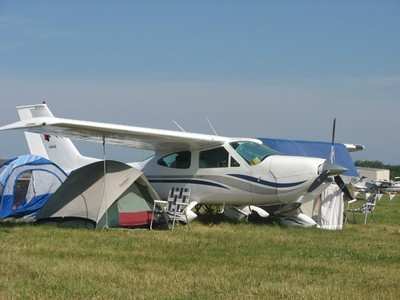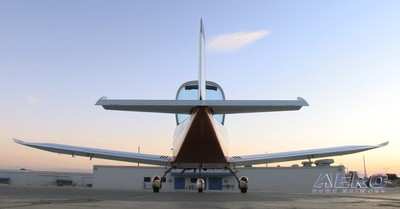Trickle down economics not always market friendly
By: Gene Yarbrough
Of the many exhibitors and vendors at Oshkosh, insurance carriers and brokers are an often overlooked, but necessary part of aircraft ownership and operation. ANN spoke with Casey Delanghe of Assured Partners on the ever changing landscape of Aircraft insurance. The rising cost of aircraft owners' insurance has become a significant concern within the aviation industry. Various factors contribute to these escalating premiums, affecting individual aircraft owners, flight schools, charter operators, and larger aviation businesses. Understanding the dynamics behind these cost increases is crucial for stakeholders to manage expenses and ensure continued operations.

Casey stated “One of the primary drivers of higher insurance premiums is the aging fleet of general aviation aircraft”. Many private planes, particularly those used in general aviation, are several decades old. As aircraft age, maintenance needs increase, and the risk of mechanical failure rises, leading insurers to charge more to cover potential claims. The cost of sourcing parts and skilled labor for older models further exacerbates this issue, contributing to the higher overall cost of insuring these aircraft.
Casey also emphasized that “The insurance industry has seen a rise in the number and size of claims in recent years”. Accidents, while fortunately not increasing in frequency, have become more expensive in terms of damages and litigation costs. Higher medical costs, legal fees, and the increasing value of claims for pain and suffering have driven up the total payout’s insurers must cover. These higher payouts result in insurers needing to raise premiums to maintain profitability and cover their risks adequately.
The aviation industry is experiencing a significant pilot shortage, leading to an influx of less experienced pilots. Insurers consider pilot experience a critical factor when determining premiums. Less experienced pilots are statistically more likely to be involved in incidents, prompting insurers to increase rates to mitigate the higher risk. This situation is particularly impactful for new pilots entering the field and for flight schools training these individuals, as it directly increases their operational costs. Conversely older pilots are the primary group comprising personal aviation consumers, and similar degradation of pilot skills manifests as higher accident rates for this group. Compounded by a relatively small insurance pool to amortize costs over, compared to automotive, home and property insurance pools, means a small bucket to pay claims out of and a smaller number of consumers to spread costs upon.

While technological advancements in aviation have improved safety and performance, they have also increased the cost of repairs. Modern aircraft are equipped with sophisticated avionics and systems that, if damaged, can be expensive to repair or replace. Insurers account for these higher repair costs in their premium calculations. Additionally, as technology evolves, the need for specialized maintenance and repair services increases, further driving up costs.
The frequency and severity of natural disasters have been rising, attributed to climate change. Events such as hurricanes, floods, and wildfires can cause substantial damage to aircraft, whether in flight or on the ground. Insurers must factor in these risks, especially in regions prone to such events, leading to higher premiums for aircraft owners in those areas. The unpredictability of these occurrences makes risk assessment more challenging and costly for insurers.
Regulatory changes and enhanced compliance requirements also contribute to the rising cost of aircraft owners' insurance. New regulations often mandate upgrades to aircraft systems or additional maintenance protocols, increasing operational costs for owners. Insurers, in turn, adjust their premiums to reflect the increased risk and potential costs associated with ensuring compliance with these evolving regulations.
The global insurance market conditions and the cost of reinsurance—insurance that insurers purchase to mitigate their own risks—also play a significant role in shaping premium rates. Economic downturns, investment losses, and other market pressures such as foreign wars can lead to higher reinsurance costs, which are then passed on to aircraft owners through increased premiums. Casey noted “The war in Ukraine, and the resulting actions by Russia in repatriating certain aircraft into Russia, rather than allowing those aircraft to return to their home countries, incurred billions in insurance claims affecting global insurance market forces”.

Aircraft owners can take several steps to mitigate the impact of rising insurance costs. Investing in additional pilot training and maintaining a strong safety record can help reduce premiums. Upgrading older aircraft with modern safety features and adhering to rigorous maintenance schedules can also lower risks. Additionally, shopping around for insurance and working with brokers who specialize in aviation insurance can help find the most competitive rates.
The increasing cost of aircraft owners' insurance is a multifaceted issue influenced by aging fleets, higher claims, pilot shortages, technological advancements, natural disasters, regulatory changes, and market conditions. By understanding these factors, aircraft owners can better navigate the complexities of insurance and adopt strategies to manage their insurance expenses effectively.
 Aero-News: Quote of the Day (12.18.25)
Aero-News: Quote of the Day (12.18.25) Classic Aero-TV: Viking Twin Otter 400--Bringing the DHC-6 Back Into Production
Classic Aero-TV: Viking Twin Otter 400--Bringing the DHC-6 Back Into Production NTSB Final Report: Rans Employee Flying Club Rans S-6ES Coyote II
NTSB Final Report: Rans Employee Flying Club Rans S-6ES Coyote II ANN FAQ: Submit a News Story!
ANN FAQ: Submit a News Story! ANN's Daily Aero-Term (12.18.25): Braking Action Advisories
ANN's Daily Aero-Term (12.18.25): Braking Action Advisories





